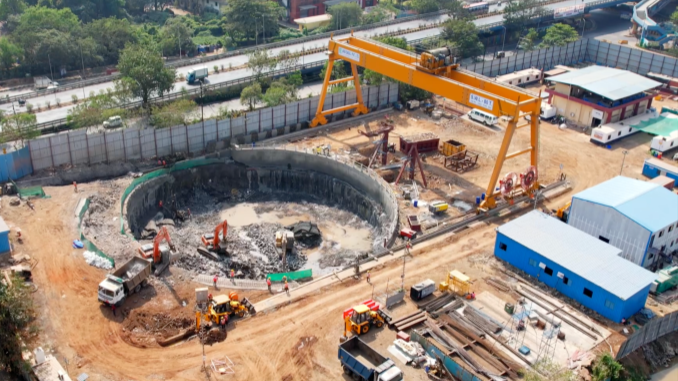
The ambitious Bullet Train Project in Maharashtra, led by the National High Speed Rail Corporation Limited (NHSRCL), is making significant strides as the construction of India’s first underground and undersea tunnel moves forward smoothly.
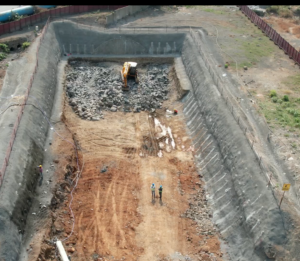
More Details:
The 21 km long India’s first underground/undersea tunnel is under construction between bullet train underground station at Bandra-Kurla Complex and Shilphata in the State of Maharashtra.
Construction Work has Already Begun at Following Locations:
- Shaft 1 at Mumbai Bullet Train station construction site: Shaft depth of 36 metres, 100% secant piling work completed, excavation work is currently underway.
- Shaft 2 in Vikhroli : Shaft depth of 56 metres, 100% piling work completed, excavation work is currently underway. This shaft will be used to lower two tunnel boring machines in two different directions, one towards BKC and another one towards Ghansoli.
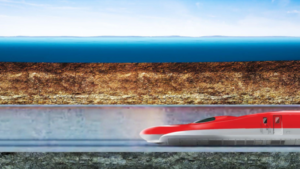
- Shaft 3 in Sawli (near Ghansoli): Shaft depth of 39 metres, excavation work is currently underway.
- Shilphata: This is the NATM end of the tunnel. Portal work has already begun at the site.
- ADIT (Additionally Driven Intermediate Tunnel) Portal: This portal will facilitate additional access to the underground/undersea tunnel for faster construction progress.
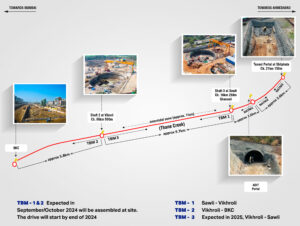
Some of the Challenges in Construction of Shafts:
- Multiple controlled blasting with sufficient noise and air pollution prevention measures so as to cause minimal disturbance to the environment and population in the adjoining areas.
- Shafts are constructed in areas with high population density and adjoining utilities like various pipelines, electrical installation and other adjoining infrastructure projects like Metro, highways etc. It is being ensured that work is being done with minimal disruption.
- Disposal of excavated material under supervision of Maharashtra pollution control board (MPCB) through each trip approval and GPS tracker etc.
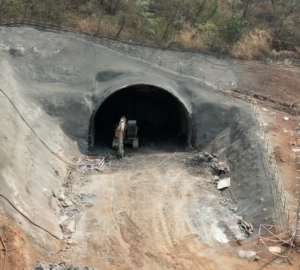
- Various other facilities like Gantry cranes, labour colonies, site offices are also being constructed in tandem.
Additional Details:
- The tunnel will be a single tube tunnel to accommodate twin tracks for both-up and down track. 39 equipment rooms will also be constructed adjoining the tunnel location as part of the package.
- To construct this tunnel of diameter 13.1 m, TBMs with a cutter head of 13.6 Metre diameter will be used. Usually 5-6 Metre Diameter cutter heads are used for urban tunnels used in MRTS – Metro system.
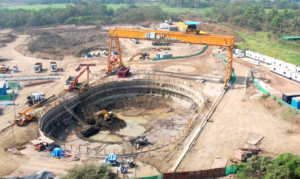
- Three Tunnel Boring Machines will be used to make about 16 km of the tunnel portion and the remaining 5 km will be through New Austrian Tunnelling Method (NATM).
- This tunnel will be about 25 to 57 Metres deep from the ground level and the deepest construction point will be 114m below the Parsik hill.
- Three shafts at BKC (under package C1), Vikhroli, and Sawli at approximate depths of 36, 56 and 39 Meter depths respectively will facilitate the construction.
- Inclined Shaft of 42 Meter at Ghansoli and Tunnel portal at Shilphata will facilitate the construction of approx. 5 km of tunnel through NATM tunnelling method.
Conclusion:
The progress in the construction of the underground and undersea tunnel for the Bullet Train Project in Maharashtra marks a significant milestone in India’s infrastructure development. Despite challenges, meticulous planning and execution are ensuring the project’s advancement while minimising environmental impact and disruption to surrounding areas. As work continues, the Bullet Train Project stands as a testament to India’s commitment to modernising its transportation infrastructure and embracing cutting-edge technology for the benefit of its citizens and the nation’s future.
Source: NHSRCL- Press Release | Images Credit: NHSRCL
Join us for the upcoming 5th Rail & Metro Technology Conclave with 600+ Top Rail & Metro Industry Leaders on 23rd & 24th July, 2024 in New Delhi, India. Register here and participate in the summit.

